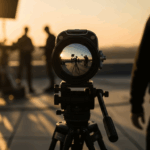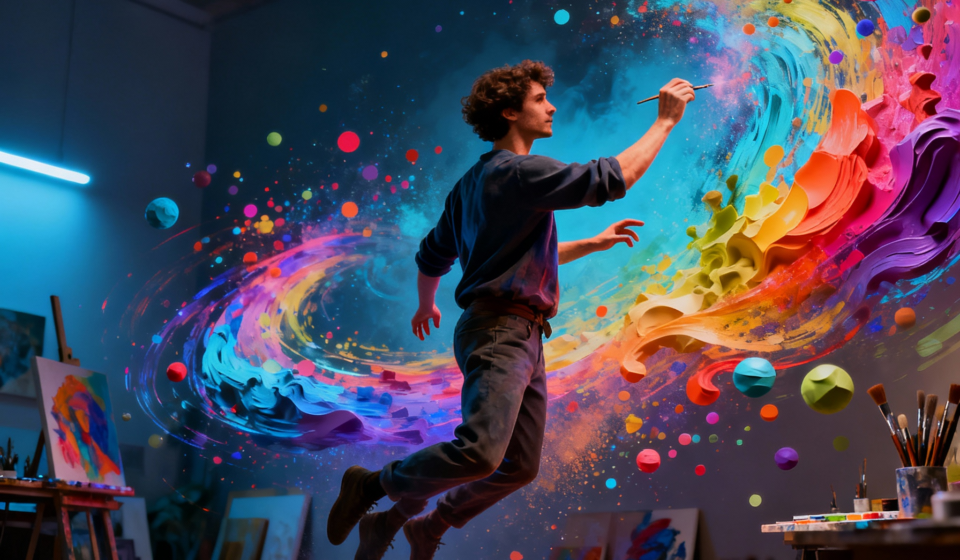
The Power of AI Prompts: How to Turn Your Imagination into Stunning Visual Reality
In an era where creativity meets computation, artificial intelligence has emerged as one of humanity’s most powerful tools for visual expression. The ability to transform words into vivid, breathtaking imagery represents a fundamental shift in how we conceptualize and create art. At the heart of this revolution lies a deceptively simple yet infinitely complex skill: prompt engineering—the art of crafting descriptive text instructions that guide AI systems to generate precisely what we envision. Through carefully constructed prompts, creators worldwide are discovering that the boundary between imagination and reality has become remarkably thin, enabling anyone with vision and vocabulary to become a visual storyteller.
Table Of Content
- Understanding the Anatomy of Effective AI Prompts
- The Psychology Behind Prompt-Driven Creativity
- Crafting Prompts for Different Creative Applications
- Literary and Artistic Techniques in Visual Prompts
- Prompt Engineering as Professional Skill and Art Form
- Ethical Considerations and Creative Authenticity
- The Future of Imagination Made Visual
- Conclusion: Words as the New Creative Medium
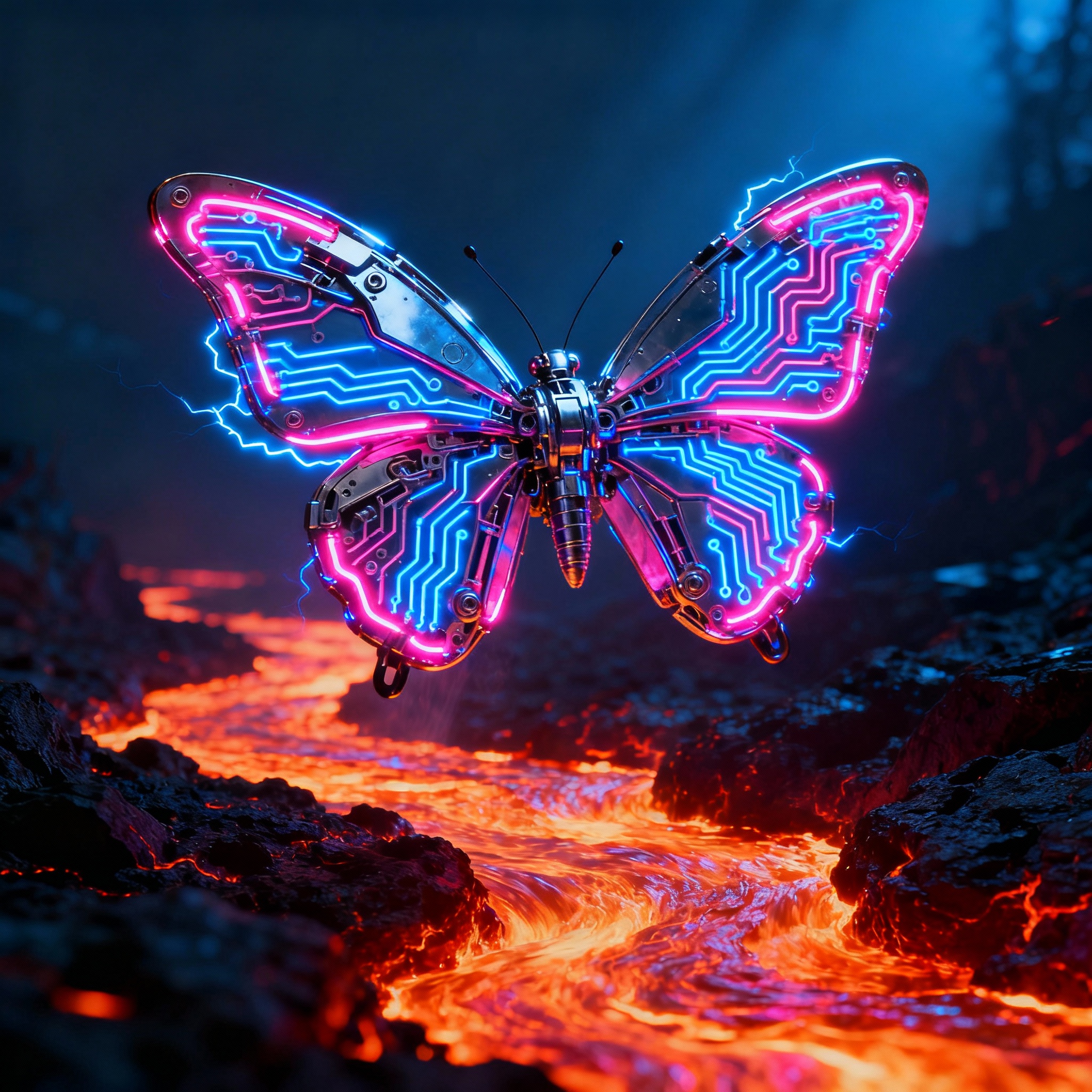
The journey from abstract thought to tangible image begins with understanding that AI image generators like DALL-E, Midjourney, Stable Diffusion, and others function as collaborative partners rather than mere tools. These systems have been trained on millions of images paired with descriptive text, learning the intricate connections between language and visual elements. When you provide a prompt, the AI doesn’t simply retrieve existing images—it synthesizes entirely new visuals by combining learned patterns about composition, lighting, texture, color, and style. This process transforms the creator’s role from technical executor to imaginative director, where success depends not on manual dexterity with brushes or software, but on the ability to articulate vision with precision and creativity.
Understanding the Anatomy of Effective AI Prompts
Creating compelling AI art through prompts requires understanding the fundamental building blocks that constitute effective instructions. At its most basic level, an effective prompt contains several key components that work together to guide the AI toward your desired outcome. The subject forms the foundation—this is what you want the image to depict, whether it’s a person, object, creature, or abstract concept. However, simply stating “a cat” or “a mountain” produces generic results that rarely capture the magic you envision.
Prompt: A glowing cybernetic jellyfish drifting through a dark city alley filled with holograms, wet pavement reflecting neon signs, cinematic lighting with slow-motion crowds blurring around, cyberpunk color grading. 📋 Copy Prompt

The true power of prompt engineering emerges when you layer descriptive details onto your subject. These details include the art style or medium (photography, oil painting, digital art, watercolor, pencil sketch), the mood and atmosphere (ominous, joyful, melancholic, energetic), the lighting conditions (golden hour, dramatic shadows, soft diffused light, neon glow), and the composition (close-up, wide-angle, bird’s eye view, rule of thirds). Research has demonstrated that prompts incorporating specific artistic references—such as “in the style of Van Gogh” or “trending on ArtStation”—significantly improve output quality because these phrases activate learned associations with particular aesthetic qualities. The phrase “trending on ArtStation,” for example, has become known as a “quality booster” that nudges AI toward producing more polished, professional-looking results.
Prompt Modifiers That Enhance Quality:
-
Technical specifications: 4K resolution, ultra-realistic, highly detailed, photorealistic, HDR
-
Artistic movements: Impressionism, surrealism, Art Nouveau, minimalism, baroque
-
Lighting descriptors: Volumetric lighting, rim lighting, golden hour, studio lighting, bioluminescent
-
Camera terminology: Shallow depth of field, wide-angle lens, macro photography, long exposure
-
Platform references: Trending on ArtStation, featured on Behance, award-winning
-
Emotional qualities: Ethereal, ominous, whimsical, dramatic, serene, mysterious
The structure of your prompt matters significantly for achieving consistent results. Many experienced prompt engineers follow a formula that places the most important elements at the beginning, as AI systems often weight earlier words more heavily. A common effective structure follows this pattern: [Subject] + [Action/Pose] + [Environment/Setting] + [Style/Medium] + [Lighting] + [Mood] + [Technical Quality]. For instance, rather than writing “make me a robot,” an optimized prompt would read: “A weathered steampunk robot standing in a Victorian workshop, examining clockwork mechanisms, oil painting style with warm amber lighting, intricate brass details, atmospheric dust particles, 8K resolution”.
The Psychology Behind Prompt-Driven Creativity
The relationship between human creativity and AI assistance represents a fascinating psychological phenomenon that challenges traditional notions of artistic authorship. When creators craft prompts for AI art generation, they engage in what researchers call “cognitive offloading”—delegating certain mental processes to external systems while retaining creative control over conceptual direction. This division of labor allows artists to focus their mental energy on ideation, composition, and aesthetic decision-making rather than technical execution. Studies examining prompt engineering as a creative skill have found that while most people can describe what they want in general terms, effective prompting requires acquiring specialized knowledge about style-specific vocabulary and technical modifiers that novices typically lack.
“Any sufficiently advanced technology is indistinguishable from magic.” — Arthur C. Clarke
The democratization of visual creation through prompt-based AI tools has profound implications for creative industries. Designers, marketers, content creators, and independent artists who previously faced barriers due to limited technical skills or expensive software can now produce professional-quality visuals. According to industry data, 62% of marketing professionals have already incorporated AI-generated visuals into their campaigns, while 45% of design agencies use AI tools to supplement or accelerate their creative processes. The global AI image generation market is projected to reach $1.3 billion by 2025, with a compound annual growth rate of approximately 35.7%. These statistics underscore how rapidly prompt-driven creation has moved from experimental novelty to essential professional capability.
Prompt: An abstract representation of creativity, with colorful neural pathways and flowing energy streams merging into a luminous brain, digital art style with vibrant gradients, symbolizing the fusion of human imagination and artificial intelligence. 📋 Copy Prompt
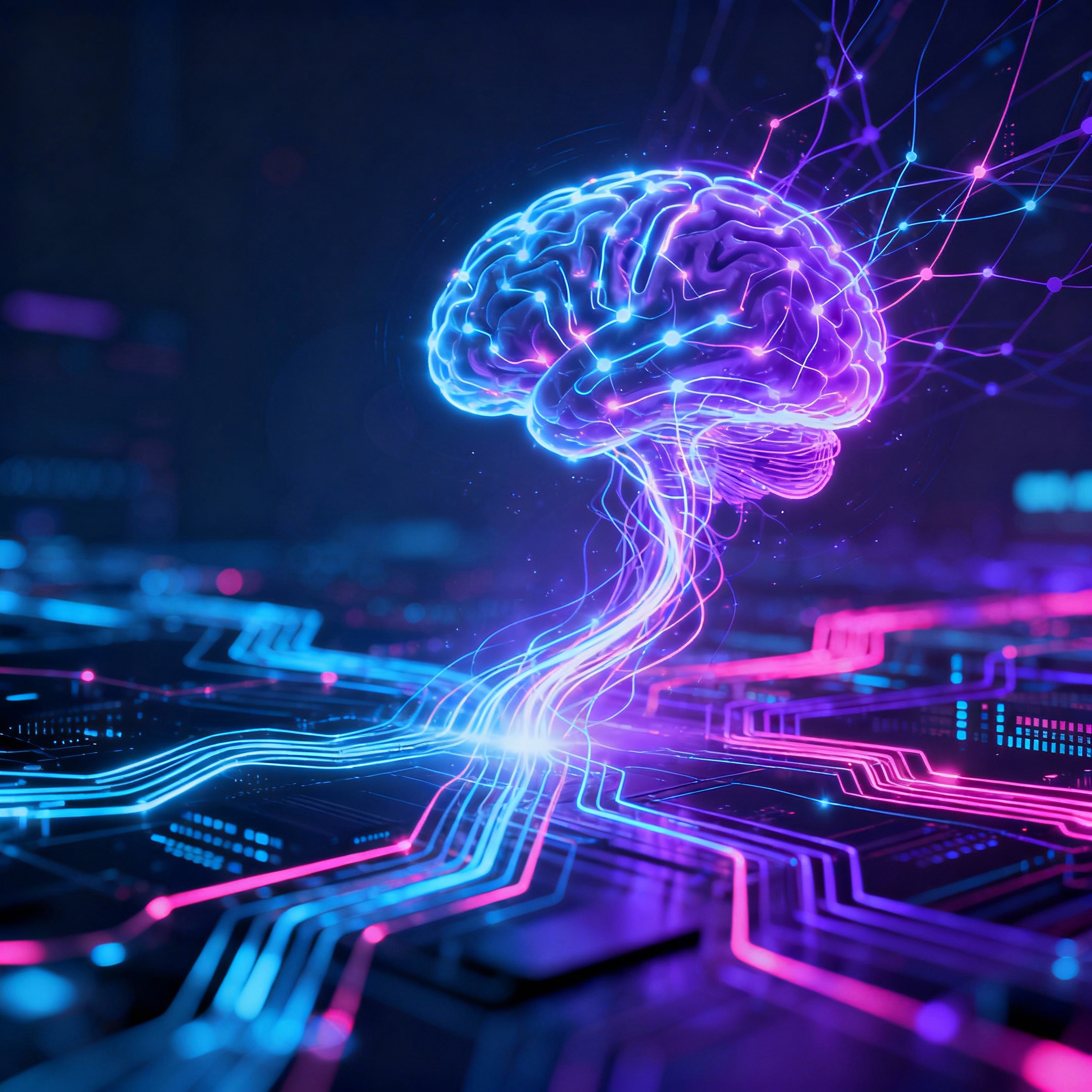
However, this technological empowerment also introduces new creative constraints and considerations. When artists work with AI through prompts, they must navigate the tension between their original vision and the AI’s interpretation, which is fundamentally shaped by its training data. Chinese visual artists studied in 2024 described this dynamic as learning to “misuse” AI creatively—deliberately prompting the system in unexpected ways to maintain originality and avoid generic outputs. The most successful creators approach prompt engineering not as a one-time instruction but as an iterative dialogue, refining and adjusting their prompts based on the AI’s responses until they achieve results that align with their vision. This iterative process mirrors traditional artistic practice, where creators continuously evaluate and refine their work, except the medium of refinement is language rather than physical materials.
Crafting Prompts for Different Creative Applications
The versatility of AI image generation becomes apparent when examining how prompt strategies differ across various creative applications. For marketing and advertising, prompts must balance aesthetic appeal with brand consistency and message clarity. Marketing professionals often structure prompts to specify not just visual elements but also the emotional response they want to evoke in viewers. A prompt for a wellness brand might read: “Serene woman practicing yoga at sunrise on a mountain peak, soft golden lighting, peaceful expression, minimalist composition, pastel color palette, professional photography style, evokes feelings of calm and balance”. The specificity around emotional tone helps ensure the generated image aligns with brand values and resonates with target audiences.
Prompt: A holographic architect examining floating 3D building blueprints in a futuristic office, virtual reality interface with glowing data streams, photorealistic lighting with blue and white tones, professional composition, technology meets creativity. 📋 Copy Prompt

For product design and conceptualization, prompts focus on materiality, functionality, and aesthetic details that help visualize potential products before physical prototyping. Industrial designers use AI prompts to rapidly generate multiple design variations, iterating through concepts at speeds impossible with traditional sketching or 3D modeling. A furniture designer might prompt: “Modern ergonomic office chair with sustainable bamboo frame, navy blue recycled fabric upholstery, chrome adjustments, minimalist Scandinavian design, studio lighting against white background, product photography, sharp focus on material textures”. This approach dramatically reduces the time and cost associated with early-stage design exploration.
Social media content creation demands a different prompting approach, emphasizing visual impact, emotional resonance, and platform-specific formatting. Creators generating content for Instagram, TikTok, or Pinterest often include aspect ratio specifications (9:16 for vertical video platforms, 1:1 for Instagram feed posts) and design for immediate visual appeal that stops scrolling. Prompts for social media frequently incorporate trending aesthetic styles—currently popular approaches include “Y2K nostalgia,” “cottagecore,” “dark academia,” and “vaporwave”—because these recognizable styles perform well with platform audiences. A social media prompt might specify: “Aesthetic flat lay of morning coffee setup, warm earthy tones, minimalist composition, soft natural window lighting, cozy lifestyle photography, Instagram-worthy, cottagecore aesthetic”.
Literary and Artistic Techniques in Visual Prompts
Advanced prompt engineering borrows extensively from literary and artistic traditions, applying principles of descriptive writing, poetry, and art criticism to construct more evocative instructions. The most compelling prompts often employ sensory language that helps the AI understand not just what to depict but the experiential qualities of the scene. Rather than simply stating “forest,” a sensory-rich prompt might describe “an ancient forest where dappled sunlight filters through emerald canopy, moss-covered stones glisten with moisture, distant bird calls echo through mist-shrouded trees”. This narrative approach provides the AI with richer contextual information, resulting in images with greater atmospheric depth.
Literary devices that enhance prompt effectiveness include:
-
Metaphor and symbolism: “A lighthouse of hope standing against storms of uncertainty”
-
Personification: “Mountains that cradle the valley in protective arms”
-
Synesthesia: “The sound of color bleeding across the canvas”
-
Juxtaposition: “Ancient ruins embracing futuristic technology”
-
Alliteration: “Shimmering silver streams spiraling skyward”
Understanding art historical references exponentially expands your prompt vocabulary and stylistic range. When you reference specific artists—”in the style of Claude Monet,” “reminiscent of Frida Kahlo’s self-portraits,” “echoing Banksy’s street art aesthetic”—you activate the AI’s learned associations with those artists’ characteristic techniques, color palettes, and compositional approaches. Similarly, referencing art movements provides broad stylistic direction: Impressionism suggests loose brushstrokes and emphasis on light, Surrealism indicates dreamlike juxtapositions, Minimalism implies stripped-down essential elements, while Baroque evokes drama and ornate detail. Combining multiple artistic references can yield particularly unique results: “Portrait in the style of Gustav Klimt’s golden period merged with contemporary digital glitch art”.
Prompt: A digital artist creating floating 3D artwork in mid-air using hand gestures, colorful particles and light trails following movements, immersive creative workspace, cinematic composition with dramatic lighting, representing the future of artistic creation. 📋 Copy Prompt
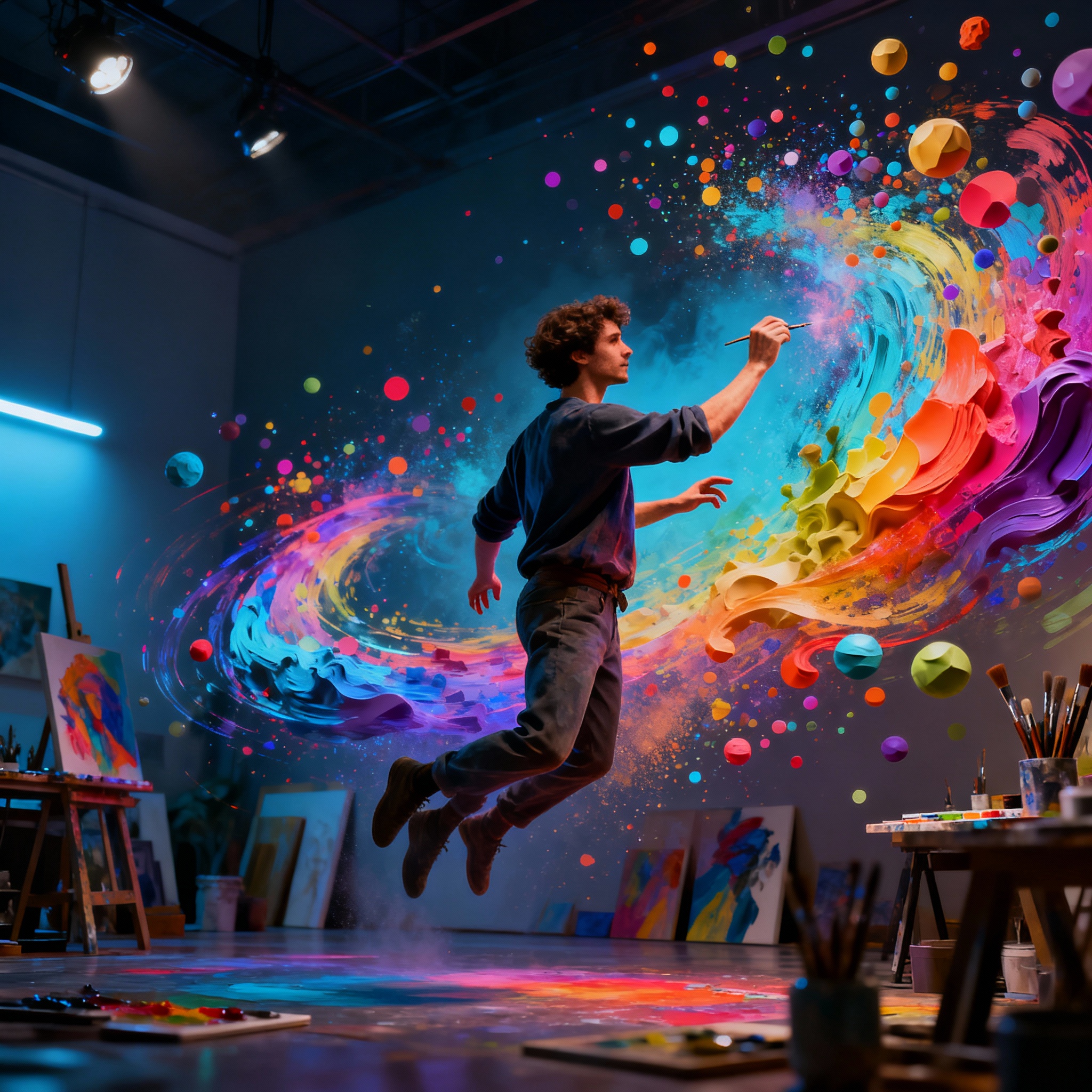
Cinematographic language provides another powerful vocabulary for prompt engineering, particularly useful when creating narrative or atmospheric images. Film terminology allows precise control over framing, camera angles, and visual storytelling: “low-angle shot emphasizing power,” “Dutch angle creating unease,” “establishing wide shot of sprawling landscape,” “intimate close-up revealing emotion,” “over-the-shoulder perspective suggesting observation”. Lighting terminology from cinematography—”three-point lighting,” “high-key brightness,” “low-key shadows,” “rim lighting,” “volumetric rays”—gives you fine control over mood and visual impact. A cinematically-informed prompt might read: “Film noir detective in rain-soaked alley, dramatic side lighting casting long shadows, shallow depth of field, grainy black and white photography, Dutch angle composition, atmosphere of mystery and danger, directed by Christopher Nolan aesthetic”.
Prompt Engineering as Professional Skill and Art Form
As AI image generation tools have matured and proliferated, prompt engineering has evolved from hobbyist experimentation into a recognized professional skill with commercial value. Companies across creative industries now employ specialists whose primary role involves crafting and optimizing prompts to generate consistent, high-quality visual assets. Some organizations have advertised positions for “prompt engineers” with salaries ranging from $250,000 to $335,000 annually, reflecting the strategic importance of this emerging capability. These roles require not just creative vision but systematic methodology—understanding how to structure prompts for consistency across projects, documenting effective patterns, and continuously refining approaches based on results.
“Imagination will take you everywhere.” — Albert Einstein
The professionalization of prompt engineering has led to the development of best practices frameworks and standardized techniques that improve prompt effectiveness. Researchers and practitioners have identified several strategies that consistently yield better results. Contextual framing—providing the AI with explicit role instructions like “Act as a professional photographer” or “You are an art director for a luxury brand”—helps orient the system toward appropriate aesthetic choices. Negative prompting—explicitly stating what you don’t want in the image—prevents common AI artifacts and unwanted elements: “No distorted faces, no extra fingers, no watermarks, no text”. Weighted keywords—using syntax like “(keyword:1.5)” to emphasize importance—allows fine-tuned control over compositional priorities in some systems.
Prompt: A surreal crystal forest with glowing trees, bioluminescent mushrooms, floating islands in mist, ethereal magical atmosphere, fantasy digital art with vibrant colors, dreamlike composition, otherworldly beauty symbolizing limitless imagination. 📋 Copy Prompt
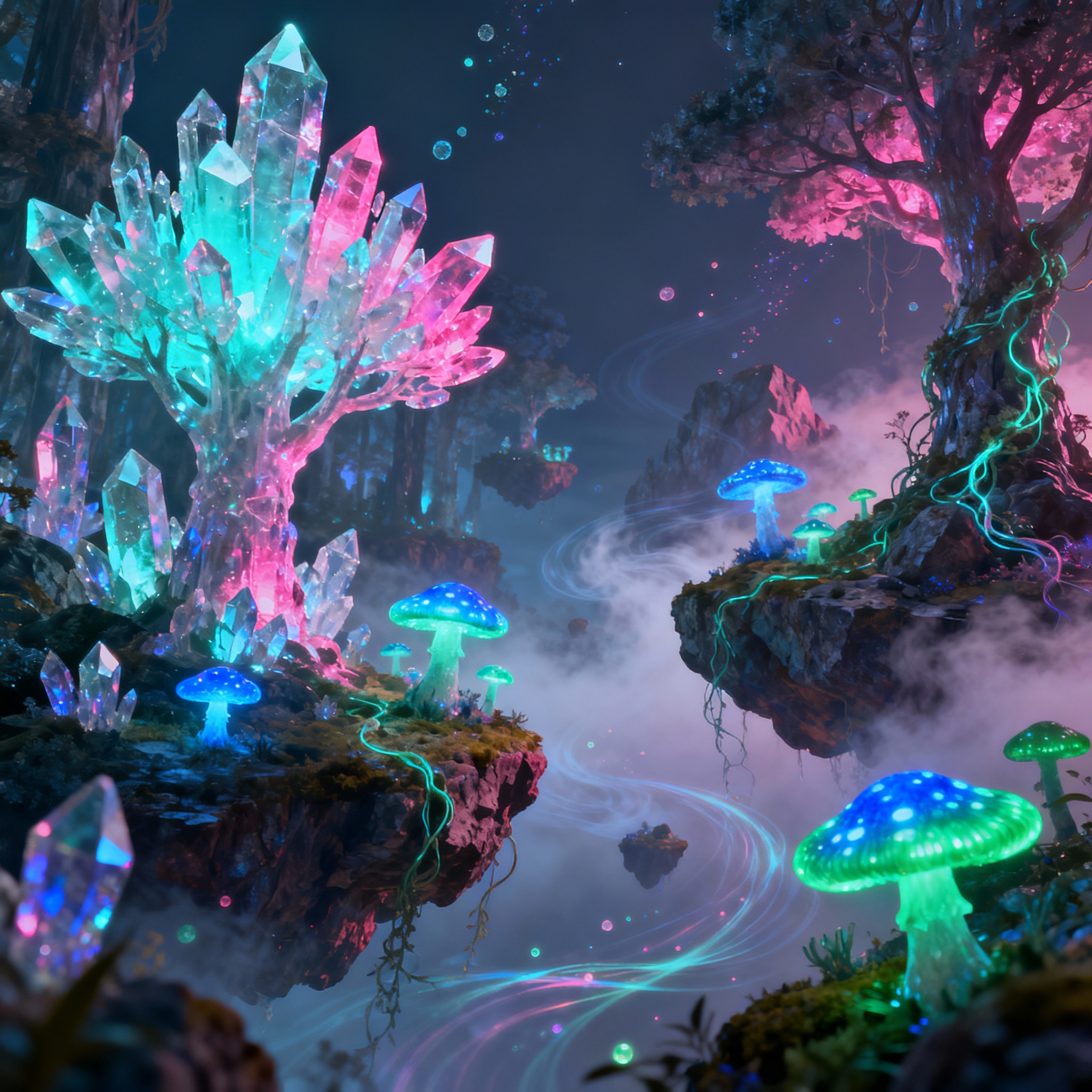
The iterative nature of effective prompt engineering parallels traditional creative processes but operates at dramatically accelerated timescales. Where a traditional illustrator might spend hours or days refining a single image, prompt engineers can generate dozens of variations in minutes, rapidly testing different approaches and combinations. This speed enables a “test-and-learn” methodology where creators systematically vary individual prompt elements to understand their effects. Professional prompt engineers maintain personal libraries of effective phrases, successful prompt structures, and style combinations that reliably produce desired results. They approach prompt creation as both art and science—balancing creative intuition with empirical testing to develop reliable workflows.
Ethical Considerations and Creative Authenticity
The rise of AI-generated art through prompt engineering has sparked intense debate about creative ownership, artistic authenticity, and the ethics of AI training data. When an AI system generates an image based on your prompt, questions arise about authorship: Is the creator the person who wrote the prompt, the developers who built the AI system, the artists whose work formed the training data, or some combination of all three? Current copyright law in many jurisdictions remains unsettled on AI-generated content, though general consensus suggests that AI outputs cannot themselves be copyrighted, while the human creative contribution (the prompt and selection process) may receive some protection.
The training data issue presents particularly thorny ethical challenges. Most AI image generators have been trained on massive datasets scraped from the internet, including copyrighted artworks posted by living artists who never consented to their work being used for machine learning. When prompts explicitly reference specific artists—”in the style of [contemporary artist name]”—this raises concerns about appropriation and economic harm to working creators. Some platforms have responded by implementing filters that prevent prompts referencing certain artist names, while others argue that style itself cannot be copyrighted and AI generation represents transformative use. Navigating these ethical considerations responsibly means being thoughtful about when and how you reference specific artists, supporting creators whose styles inspire your work, and being transparent when sharing AI-generated content.
The question of creative authenticity extends beyond legal issues to philosophical questions about the nature of creativity itself. Critics argue that prompt-based creation lacks the skill, intention, and embodied practice traditionally associated with artistic work—that it’s merely “pushing a button” rather than genuine creation. Proponents counter that prompt engineering requires substantial creative skill, aesthetic judgment, and iterative refinement, and that the barrier to entry shouldn’t define artistic validity. Research examining prompt engineering as a creative practice found that while generating AI art appears deceptively simple, consistently producing high-quality, original work requires developing specialized knowledge that must be acquired through practice—suggesting prompt engineering is indeed a skill rather than mere automation.
Key Ethical Guidelines for Responsible AI Art Creation:
<ul> <li>**Credit and transparency:** Clearly disclose when images are AI-generated rather than manually created</li> <li>**Artist attribution:** When drawing direct inspiration from specific artists’ styles, acknowledge them</li> <li>**Commercial considerations:** Understand platform-specific terms of service regarding commercial use of AI-generated images</li> <li>**Training data awareness:** Support platforms that use ethically-sourced or opt-in training data where possible</li> <li>**Human oversight:** Use AI as a tool that augments rather than replaces human creative judgment and decision-making</li> <li>**Avoid harmful content:** Refrain from generating imagery that could be used for deception, misinformation, or harm</li> </ul>
The Future of Imagination Made Visual
As AI technology continues advancing at remarkable pace, the future of prompt-driven visual creation promises even more sophisticated capabilities that blur boundaries between imagination and manifestation. Current frontier models already demonstrate multimodal integration, generating not just static images but incorporating text, motion, and even sound into cohesive visual experiences. Companies like BytePlus and Magic Hour are developing platforms where users can create animations, concept reels, and visual effects using prompts and minimal adjustments. The next generation of AI systems will likely enable real-time interactive experiences where environments dynamically respond to natural language input—essentially creating “holodecks” where spoken prompts immediately reshape the visual world around you.
The convergence of AI image generation with other technologies opens fascinating possibilities for industries far beyond traditional art and design. In architecture and urban planning, professionals already use prompt-driven AI to rapidly visualize building concepts, explore spatial arrangements, and generate multiple design iterations in hours rather than weeks. In gaming and interactive entertainment, procedural generation powered by AI promises virtually infinite content creation, where entire game worlds, characters, and narratives emerge from carefully crafted prompt systems. In film and television production, virtual production techniques combining AI-generated environments with traditional filming are revolutionizing how stories are told, reducing costs while expanding creative possibilities.
Emerging applications of prompt-driven AI creativity:
<ul> <li>**Virtual reality environments:** Generating immersive 3D spaces from text descriptions for VR experiences</li>[27][29][31] <li>**Personalized education:** Creating custom illustrations and diagrams tailored to individual learning styles</li>[32][27] <li>**Medical visualization:** Rendering complex biological and anatomical imagery for research and training</li>[30][15] <li>**Fashion and textile design:** Generating pattern variations and product mockups for apparel industry</li>[16][14] <li>**Therapeutic applications:** Supporting art therapy and mental health treatment through creative expression</li>[31][32] <li>**Scientific simulation:** Visualizing complex data, molecular structures, and theoretical concepts</li>[15][30] <li>**Real-time content adaptation:** Dynamically generating imagery that responds to user preferences and context</li>[27][31] </ul>
Perhaps most profoundly, prompt-driven AI creativity represents a fundamental shift in how humans interface with technology and manifest ideas. Where previous creative tools required mastering specific technical skills—learning to manipulate brushes, cameras, or software interfaces—prompt engineering makes creative expression accessible through natural language, the most fundamental human communication method. This democratization doesn’t eliminate the need for creative vision, aesthetic judgment, or conceptual sophistication; rather, it removes technical barriers that previously prevented people with ideas but without specialized training from bringing their visions to life. As one researcher noted, “The most valuable creators of tomorrow will be prompt engineers, architects, and strategic thinkers who effectively collaborate with AI assistants”.
The evolution toward what some call “prompt-driven development” extends beyond visual art into software creation, business processes, and problem-solving across domains. The fundamental skill being cultivated—the ability to precisely articulate desired outcomes in ways that guide intelligent systems—will likely become as essential in the 21st century as reading and writing were in previous eras. Understanding how to craft effective prompts means understanding how to communicate with the AI systems that increasingly mediate our relationship with information, creativity, and productivity.
Conclusion: Words as the New Creative Medium
The power of AI prompts to turn imagination into visual reality represents more than technological advancement—it signals a profound transformation in human creative practice and potential. Through carefully crafted text instructions, creators worldwide are discovering that the ancient human capacity for storytelling and description has found a new medium: one where words directly become images, where linguistic precision translates into visual precision, and where the only limit is the breadth of one’s vocabulary and depth of one’s vision. This is not creativity reduced or diminished, but creativity reimagined and democratized, making visual expression accessible to anyone who can describe what they envision.
The journey from prompt novice to skilled practitioner involves developing new literacies—learning the vocabulary of artistic styles and movements, understanding the technical language of photography and cinematography, recognizing which descriptive details matter most, and cultivating the iterative mindset required to refine vague ideas into precise instructions. It requires studying the work of artists throughout history not to copy but to understand, building a mental library of visual references that can be recombined in novel ways. Most importantly, it demands practice: the willingness to experiment, to iterate, to embrace unexpected results as opportunities rather than failures.
As AI technology continues advancing, the distinction between “AI art” and “human art” will likely become less meaningful than the distinction between thoughtful, intentional creation and thoughtless generation. The tool matters less than the vision guiding it, the technical method less than the creative question being explored. What remains constant is the fundamentally human act of imagining something that doesn’t yet exist and finding ways to bring it into being. In the age of AI, that act begins with words—carefully chosen, precisely arranged, and infused with intention. The canvas is no longer physical but conceptual, the brush is linguistic rather than tactile, but the essential creative impulse remains beautifully, powerfully human.


